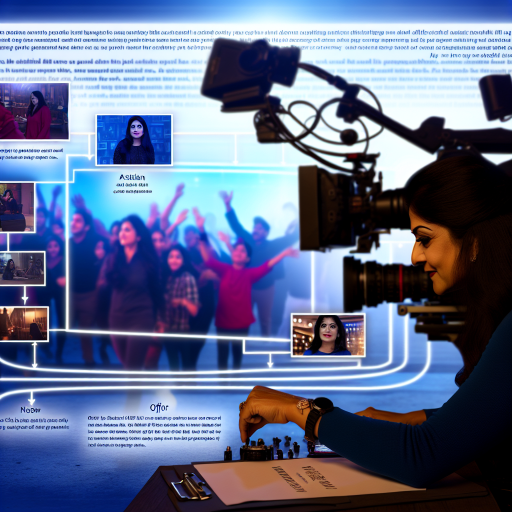Introduction
Technology has profoundly transformed film production in recent years.
From pre-production to post-production, every stage benefits from innovation.
Filmmakers now utilize advanced tools to enhance creativity and efficiency.
This evolution has made high-quality filmmaking more accessible to diverse creators.
Importance of Technology in Film Production
Technology plays a crucial role in shaping the film industry today.
Digital cameras have replaced traditional film stock, allowing for clearer images and greater flexibility.
Filmmakers can now shoot in various conditions without worrying about light exposure or developing costs.
Editing software has revolutionized how filmmakers assemble their stories.
Programs like Adobe Premiere and Final Cut Pro enable editors to work with ease.
These tools offer sophisticated features that allow for precise cuts, visual effects, and color grading.
Additionally, advancements in special effects technologies have transformed what is possible on screen.
Creators can now render stunning visual effects using computer-generated imagery (CGI).
This technology allows for the depiction of fantastical worlds and creatures that were once impossible to create.
Sound design has also benefited from technological advancements.
High-quality microphones and digital audio workstations enable sound designers to capture and manipulate sound with exceptional clarity.
This enhances the overall viewing experience for audiences.
Online platforms have changed film distribution and consumption.
Filmmakers can now showcase their work on streaming services, reaching a global audience.
Distributing films online reduces costs and democratizes access to cinema.
Technology has drastically changed film production in many ways.
Transform Your Career Today
Unlock a personalized career strategy that drives real results. Get tailored advice and a roadmap designed just for you.
Start NowIt empowers filmmakers to explore new creative horizons.
As technology continues to advance, we can only imagine the future innovations that will shape the film industry.
Advancements in Camera Technology
The film industry has undergone significant changes over the decades.
These changes largely stem from advancements in camera technology.
Today, filmmakers have access to incredible tools that dramatically influence how films are created.
By examining the evolution of cameras, we can appreciate their impact on the quality of footage.
Evolution of Cameras in the Film Industry
Understanding camera evolution helps to highlight the technology’s transformative power.
Here’s a brief timeline of key milestones:
- Early Film Cameras (1890s): These cameras utilized manual operation and chemical processes.
- Silent Era (1920s): Filmmakers introduced innovative designs, allowing for more stable and reliable shooting.
- Sound Era (1930s): The need for synchronized sound pushed advancements in camera technology.
- Cinematography Advances (1950s-1960s): Visionary filmmakers began to experiment with color and special effects.
- Digital Revolution (1980s): The transition from film to digital changed everything.
- High Definition (2000s): Filmmakers began adopting HD cameras, raising the bar for video quality.
- 4K and Beyond (2010s-Present): Filmmakers now use 4K and higher-resolution cameras.
Impact on Quality of Footage
The advancements in camera technology have dramatically improved the quality of film footage.
Here are some of the key areas impacted:
- Resolution: Higher resolution cameras capture more details.
- Dynamic Range: Modern cameras have enhanced dynamic ranges.
- Low Light Performance: Advanced sensor technology allows filming in low-light situations.
- Digital Stabilization: Camera stabilization techniques reduce unwanted movement.
- Film Emulation: Digital cameras can replicate the look of film.
- Lens Varieties: The market offers numerous lens options for various styles.
- Post-Production Flexibility: Digital footage allows for extensive editing options.
Advancements in camera technology have revolutionized filmmaking.
The evolution from early filming equipment to modern digital cameras is profound.
Each significant change introduced new capabilities.
These capabilities enable filmmakers to express their visions more effectively.
Cinematic techniques have also evolved alongside technology.
Filmmakers can now explore innovative storytelling techniques.
As they utilize advanced camera features, they set new standards in cinematography.
The accessibility of high-quality cameras has democratized filmmaking.
Previously, only well-funded productions could afford top-of-the-line equipment.
Showcase Your Business Today
Reach thousands of readers actively exploring professional services. Publish your business profile and grow your audience now.
Publish NowToday, independent filmmakers can create stunning visuals with reasonably priced cameras.
The reduction in production costs has encouraged creativity.
More filmmakers can produce unique stories that break free from traditional molds.
This shift promotes a richer cinematic landscape.
Streaming services have influenced camera technology’s evolution.
With the rise of platforms like Netflix and Amazon Prime, filmmakers strive to deliver content that meets high production standards.
This demand pushes camera manufacturers to innovate continually.
Filmmakers experiment with new shooting techniques enabled by advanced camera technology.
Cinematic styles like handheld shooting and long takes actively shape viewer experiences.
As audiences embrace these innovations, they expect greater realism and engagement in films.
Advancements in camera sensors enhance visual storytelling methods.
Cinematographers manipulate lighting, focus, and angles to evoke emotions.
Today, they have tools that allow them to capture breathtaking images that resonate deeply with viewers.
As technology continues to advance, we anticipate further transformations in film production.
Innovations like AI-driven cameras and augmented reality tools will surely shape future cinematic experiences.
The blending of technology with traditional filmmaking techniques opens endless possibilities.
Advancements in camera technology have significantly impacted filmmaking.
The evolution of cameras and their features allows filmmakers to create breathtaking, high-quality footage.
As technology continues to progress, filmmakers embrace new opportunities for storytelling.
These developments enhance our cinematic experiences.
Special Effects and CGI
Transformation of Visual Effects
In the past, filmmakers relied heavily on practical effects to create stunning visuals.
These methods required detailed craftsmanship and extensive resources.
However, modern technology introduced computer-generated imagery (CGI).
CGI revolutionized the film industry by allowing creators to visualize concepts without physical constraints.
Today, filmmakers can create entire worlds using CGI.
The vast possibilities of digital effects offer endless creative freedom.
Here are some significant ways CGI transformed visual effects:
- Realism: Advances in CGI technology facilitate the creation of hyper-realistic characters and environments.
- Cost-Effectiveness: CGI reduces the expenses associated with set constructions and special props.
- Safety: Dangerous stunts can be simulated safely, protecting cast and crew.
- Flexibility: Last-minute changes are easier with computer-generated designs, allowing for quick adjustments.
- Accessibility: With the growth of affordable technology, smaller studios can produce high-quality effects.
CGI enabled filmmakers to realize their most ambitious ideas.
They can now bring mythical creatures and fantastical worlds to life in ways once thought impossible.
This advancement has changed how audiences perceive visual storytelling, blurring the lines between reality and imagination.
Enhancement of Storytelling
Special effects and CGI not only enhance visuals but also amplify storytelling capabilities.
Filmmakers utilize technology to create immersive experiences that engage viewers.
Here are several aspects of how CGI enhances storytelling:
- Enhanced Emotion: CGI allows for expressive character animations, enhancing emotional connections.
- World Building: Filmmakers can introduce diverse settings and environments vital to the story.
- Symbolism: Visual metaphors can be represented more vividly through specialized effects.
- Cohesion: Seamless integration of different elements unifies scenes, enriching the narrative.
- Audience Engagement: Stunning visuals captivate audiences, creating memorable cinematic experiences.
These enhancements create a deeper connection between the audience and the film.
In films like “Avatar,” CGI constructs intricate worlds that completely engulf viewers.
Such technology immerses audiences in environments they have never experienced before, providing a unique narrative experience.
Instead of merely watching a story, they live it.
Moreover, CGI allows filmmakers to play with time and space.
They can create flashbacks or dive into a character’s memories with powerful visual effects.
These techniques make storytelling more dynamic and engaging.
Showcase Your Business Today
Reach thousands of readers actively exploring professional services. Publish your business profile and grow your audience now.
Publish NowFilmmakers are no longer limited by physical sets or practical effects.
However, the reliance on CGI poses challenges.
A heavy reliance on technology may detract from acting and storytelling.
Filmmakers must strike a balance between practical effects and CGI.
They need to ensure that characters and emotions remain the focal point of their narratives.
The Future of Visual Effects
The future of visual effects looks promising and exciting.
Emerging technologies, like artificial intelligence, are poised to revolutionize film production further.
Here are some anticipated trends in visual effects:
- Real-Time Rendering: Technologies like Unreal Engine enable real-time rendering, enhancing production efficiency.
- Virtual Reality (VR): VR technology offers immersive storytelling possibilities, engaging audiences like never before.
- Augmented Reality (AR): Filmmakers can overlay digital information onto real environments, creating interactive experiences.
- Machine Learning: AI can automate processes, enhancing visual effects and reducing labor costs.
- Digital Doubles: Advances in motion capture will enable realistic digital doubles for actors, creating new storytelling methods.
These advancements promise to further blur the lines between reality and fiction.
They will usher in a new era of visual storytelling where imagination knows no bounds.
As technology continues to evolve, filmmakers must adapt and innovate to tell their stories effectively.
Special effects and CGI significantly impact film production.
They have transformed visual effects, making stories more realistic and immersive.
Filmmakers can now bring their visions to life with unprecedented creativity and precision.
As technology continues to advance, audiences will experience even more engaging stories that push the boundaries of imagination.
You Might Also Like: The Future of Corporate Training in Communications
Role of Editing Software in Post-Production
Editing software serves multiple essential functions in film production.
These functions significantly impact the final product.
The following list outlines key roles of editing software:
- Organizing Footage: Editors can efficiently categorize, label, and store video clips.
- Cutting and Trimming: Editors can easily cut unnecessary scenes to maintain storytelling flow.
- Color Correction: Software allows for advanced color grading, enhancing the film’s visual appeal.
- Audio Editing: Editors can adjust sound, remove noise, and mix dialogue and music seamlessly.
- Visual Effects: Editors integrate visual effects, enhancing scenes without extensive reshoots.
- Collaboration: Multiple editors can work on the same project using cloud-based platforms.
Editing software has evolved to accommodate various styles and workflows.
Editors can choose from a wide range of applications.
Popular software options include Adobe Premiere Pro, Final Cut Pro, and Avid Media Composer.
Each program offers unique features tailored to different needs.
Streamlining the Editing Process
Film editing software streamlines the editing process in numerous ways.
It simplifies tasks that once took hours.
This efficiency allows editors to focus on creativity.
Here are some specific ways editing software optimizes workflow:
- Timeline Management: The timeline feature provides a clear visual structure for scenes.
- Keyboard Shortcuts: Editors can speed up their work using customizable shortcuts.
- Drag-and-Drop Functionality: Editors can easily import and arrange footage using this intuitive feature.
- Templates and Presets: The software offers templates for effects and transitions, saving time.
- Real-Time Playback: Editors can preview edits instantly, making adjustments quicker.
- Automatic Saving: Many programs include autosave features, preventing data loss during editing sessions.
These features allow editors to manage their time more effectively.
They no longer spend excessive hours on technical tasks.
Instead, they can concentrate on crafting emotional narratives.
This change leads to a more compelling final product.
Enhancements in User Interface
Many editing software programs boast user-friendly interfaces.
An intuitive interface reduces the learning curve for new editors.
Editors can quickly familiarize themselves with software features.
This accessibility encourages experimentation and creativity.
Below are some benefits of user-friendly interfaces:
- Visual Organization: Clean layouts help editors easily locate tools and files.
- Customizable Workspaces: Editors can arrange tools according to their workflow preferences.
- Integrated Tutorials: Many programs provide built-in tutorials to help beginners learn effectively.
- Search Functions: Editors can quickly find clips, effects, or adjustments through search features.
- Responsive Design: The software adapts to different screen sizes and resolutions.
Editing software continually develops, ensuring it meets user demands.
Developers gather feedback from professionals and integrate it into updates.
This commitment to improvement enhances the editing experience for users at every level.
Collaboration Features in Editing Software
Film production often involves team collaboration.
Showcase Your Business Today
Reach thousands of readers actively exploring professional services. Publish your business profile and grow your audience now.
Publish NowEditing software recognizes this necessity and offers collaborative features.
Editors can work together from remote locations.
Here are some common collaboration tools found in editing software:
- Shared Projects: Multiple editors can access and edit the same project simultaneously.
- Commenting Tools: Team members can leave notes on specific clips for quick feedback.
- Version Control: Users can track changes and revert to previous versions when needed.
- Integrated Communication: Some software allows chat functions to discuss edits directly within the platform.
- Remote Access: Cloud storage enables access to projects from anywhere with an internet connection.
These collaboration features improve communication and streamline the editing process.
They enable teams to produce high-quality films more effectively.
With editing work divided among collaborators, everyone can contribute their strengths.
Future of Film Editing Software
The future of editing software looks promising.
Technological advancements continue shaping how editors work.
Innovations like artificial intelligence (AI) hold immense potential.
AI can assist in automating basic editing tasks, such as:
- Scene Detection: AI can detect and categorize scenes automatically.
- Music Recommendations: AI can suggest suitable soundtracks based on the footage’s mood.
- Smart Editing: AI can help create rough cuts by selecting the best takes.
- Color Grading: AI tools can analyze footage and recommend color adjustments to enhance visuals.
- Audio Enhancement: AI can automatically clean up audio tracks for clarity.
These innovations will enhance editing software’s efficiency.
Editors can increasingly rely on technology while focusing on creativity.
As we move forward, editors will continue to embrace evolving tools.
Their goal will remain consistent: crafting powerful stories through visual media.
Film editing software significantly impacts post-production.
It streamlines the editing process, enhances collaboration, and fosters creativity.
Editors equipped with advanced tools can produce compelling narratives effectively.
The future of film editing software holds countless possibilities for creativity and collaboration.
See Related Content: Key Differences Between In-house and Agency Publicists
Sound Technology in Film Production
Importance of Sound Quality in Films
Sound quality greatly influences the film experience.
It enhances storytelling and evokes emotions.
Audiences often remember a film’s sound long after viewing.
Poor sound can ruin even the best visuals.
Filmmakers focus on creating immersive soundscapes.
Great sound elevates engagement and connection.
Here are some reasons sound quality matters:
- Emotional Impact: High-quality sound establishes mood and tone.
- Clarity of Dialogue: Clear dialogue ensures the audience understands the story.
- Realism: Authentic sounds create believable environments and situations.
- Immersion: Enhanced sound design pulls viewers into the film’s world.
- Character Development: Unique sound elements can distinguish characters.
- Brand Recognition: Memorable soundtracks contribute to a film’s identity.
Advancements in Sound Recording Technology
The film industry has witnessed incredible advancements in sound recording technology.
These innovations have transformed production workflows and enhanced soundscapes.
Here’s how modern technology impacts sound recording:
- Digital Sound Recording: Digital technology replaced analog systems, improving sound quality drastically.
- Multi-track Recording: Filmmakers can now record multiple sound sources simultaneously, providing creative flexibility.
- Wireless Microphones: These offer freedom of movement and eliminate cable clutter on set.
- Field Recorders: Portable devices capture high-quality sounds in diverse environments.
- Software Innovations: Advanced software tools allow seamless editing, mixing, and sound design.
- Surround Sound Technology: Techniques like Dolby Atmos create immersive audio experiences for audiences.
The Role of Sound Designers
Sound designers play a crucial role in film production.
They shape the auditory experience.
Their work includes creating sound effects and mixing audio elements.
They enhance emotions and immersion through sound editing.
Collaborating with directors, they understand the film’s vision.
Their contributions ensure coherence in sound.
Here’s what sound designers focus on:
- Sound Effects: Designing unique sounds to enhance specific scenes.
- Ambience: Crafting background noise that complements the scene.
- Foley Art: Creating realistic sound effects through live performances.
- Music Selection: Choosing and installing background scores that elevate emotional impact.
The Evolution of Sound Technology
Sound technology has continuously evolved over the decades.
Early films showcased basic sound possibilities.
The introduction of synchronized sound marked a significant shift.
Before this, films relied on live music.
Showcase Your Business Today
Reach thousands of readers actively exploring professional services. Publish your business profile and grow your audience now.
Publish NowToday, the industry embraces sophisticated soundscapes created with technology.
Innovations like the following have revolutionized film sound:
- High-Fidelity Recording: Improved equipment allows for higher quality recordings, capturing subtleties.
- Noise-Cancellation Techniques: Advanced methods reduce unwanted background noise.
- 3D Sound Recording: Immersive technologies create spatial audio experiences.
- Synthesized Sounds: Technology enables the creation of sounds impossible in nature.
The Impact of Technology on Post-Production
Post-production plays a significant role in shaping sound in films.
Technology facilitates precise sound editing and mixing processes.
Sound editors work on dialogue, sound effects, and music integration.
Software tools like Pro Tools and Logic Pro have become essential.
They provide features that streamline workflows and improve efficiency.
The following aspects demonstrate technology’s impact in post-production:
- Automated Editing: Tools can automatically sync audio and video tracks.
- Real-Time Collaboration: Editors can work together remotely through cloud-based systems.
- Precision Editing: Advanced software allows for frame-accurate editing of sound elements.
- Sound Mixing: 3D mixing capabilities enable complex environments with various audio sources.
Future Trends in Sound Technology
Looking ahead, sound technology will continue to evolve.
With ongoing advancements, filmmakers will explore new possibilities.
The industry may witness the integration of artificial intelligence.
AI could streamline sound editing and enhance sound design.
Various emerging trends include:
- Virtual Reality Sound: Creating immersive audio experiences in VR films.
- Adaptive Soundtracks: Music that adjusts based on viewer choices in interactive films.
- AI Sound Effects: Algorithms generating custom sound effects on-the-fly.
- Cloud-Based Collaboration: Enhanced resources to support remote teamwork in sound design.
As technology advances, the film industry must adapt.
Sound technology will play an integral role in shaping cinematic experiences.
Filmmakers will continue to explore innovative methods to improve sound quality.
By leveraging the latest advancements, they can tell captivating stories that resonate with audiences.
Discover More: How to Build a Strong VFX Artist Portfolio

Distribution and Exhibition
Technology has transformed the way films reach audiences.
The rise of digital platforms has reshaped the distribution landscape significantly.
Filmmakers now have various avenues to connect with viewers globally.
Digital Distribution Platforms
Digital distribution platforms play a critical role in modern film dissemination.
Here are some key players in this arena:
- Streaming Services: Platforms like Netflix, Hulu, and Amazon Prime Video dominate the market. They offer vast libraries of films accessible to subscribers.
- Video on Demand (VOD): Services like iTunes and Google Play allow users to rent or purchase films. This model provides filmmakers a direct route to revenue.
- Social Media: Platforms like YouTube and Facebook allow filmmakers to showcase their work for free. They provide an alternative promotion channel where audiences can discover new films.
- Film Festivals: Many festivals now offer virtual screenings. This adaptation increases accessibility for filmmakers seeking to reach wider audiences.
- Direct Distribution: Filmmakers can release their films directly on their websites or via email lists. This strategy offers complete control over distribution.
These platforms carry both benefits and challenges for filmmakers.
They provide opportunities but also create competition.
Traditional methods of film distribution are morphing into more digital-centric approaches.
Impact on Film Accessibility and Reach
The technological shift greatly enhances the accessibility and reach of films.
This evolution guarantees more diverse audiences can engage with the content.
Here are some ways technology impacts film accessibility:
- Global Reach: A film produced in one country can now be viewed worldwide. Cross-cultural exposure enriches the film industry.
- Availability: Audiences can access films anytime and anywhere. This convenience improves viewer engagement and retention rates.
- Lower Barriers to Entry: Independent filmmakers can distribute their work without relying on traditional studios. Technology democratizes film distribution.
- Inclusive Content: Filmmakers can cater to various demographics and languages through subtitles and dubbing. This strategy enhances viewing experiences for non-native speakers.
- Cost-Effective Distribution: Digital platforms lower distribution costs significantly. Filmmakers save money compared to physical distribution methods.
Technology indeed changes how films reach their audience.
The traditional cinema model has faced challenges in adapting to these new systems.
However, filmmakers who embrace these platforms often find success.
Moreover, the competition between online streaming services promotes innovation.
Filmmakers continually seek new narratives and styles to capture audience interest.
This trend leads to a broader range of content available for viewers.
Despite the advantages, challenges remain in adapting to this digital age.
Because of oversaturation, it’s increasingly difficult for films to stand out.
Filmmakers must employ effective marketing strategies to promote their films.
Significance of Technology in Film Distribution
The impact of technology on film distribution and exhibition is significant.
Digital platforms expand the reach of filmmakers, allowing diverse stories to emerge.
Showcase Your Business Today
Reach thousands of readers actively exploring professional services. Publish your business profile and grow your audience now.
Publish NowAs technology continues to evolve, so too will the landscape of film distribution.
Digital distribution reshapes the industry.
Filmmakers can access global audiences directly in real-time.
They can adapt their marketing strategies to meet the demands of various platforms.
The future of film distribution looks promising, fostering greater inclusion and variety in cinema.
Learn More: Maintaining Objectivity as a News Anchor
In recent years, virtual reality (VR) has drastically changed the landscape of film production.
Filmmakers now have the opportunity to create immersive experiences that deeply engage the audience.
By utilizing VR technology, directors can transport viewers into the heart of the story.
This section explores the incorporation of VR in filmmaking and how it enhances audience engagement.
Incorporation of VR Technology in Filmmaking
The adoption of VR technology in filmmaking has opened up new realms of creativity.
Directors now leverage various tools and techniques to bring their visions to life.
Here are some notable ways VR transforms film production:
- 3D Spatial Audio: Filmmakers employ spatial audio to immerse viewers. This technique creates a sense of directionality in sound, enhancing the realism of scenes.
- 360-Degree Filming: Utilizing 360-degree cameras, filmmakers capture every angle of a scene. This technique allows viewers to look around and explore the environment.
- Interactive Storytelling: VR allows audiences to make choices that influence the narrative. This interactivity gives viewers a sense of agency and involvement.
- Virtual Sets: Directors can create elaborate sets digitally. This innovation reduces costs and logistical challenges associated with traditional filming.
- Pre-visualization with VR: Filmmakers use VR to visualize scenes before actual shooting. This process aids in planning camera angles and movements effectively.
These advancements empower filmmakers to craft unique experiences.
As a result, audiences become active participants rather than passive viewers.
This shift pushes the boundaries of traditional storytelling.
Enhancing Audience Engagement
VR technology elevates audience engagement to unprecedented levels.
By creating immersive environments, filmmakers draw viewers into the narrative.
Here are several ways VR enhances audience connection with the story:
- Immersion: The immersive quality of VR allows viewers to feel present in the film’s world. Audiences experience events as if they are part of the story, heightening emotional connections.
- Empathy Building: VR enables audiences to walk in characters’ shoes. This perspective-shifting experience fosters empathy, making stories resonate deeper.
- Front-row Experience: Viewers feel like they are sitting front and center during pivotal moments. This closeness amplifies the excitement and intensity of scenes.
- Community Experiences: VR can facilitate shared experiences among audiences. This aspect enhances social connections, encouraging discussions and reflections post-viewing.
- Artist Freedom: Filmmakers can explore unconventional narratives with VR. This freedom allows for innovative storytelling that captivates diverse audiences.
The integration of VR in film production changes how stories are told.
Filmmakers no longer stick to traditional structures.
Instead, they leverage technology to extend the narrative’s reach.
Challenges and Considerations
Despite the vast potential of VR, filmmakers face challenges in integrating this technology.
Some key considerations include:
- Production Costs: High-quality VR equipment and software can be expensive. Filmmakers must balance costs while ensuring quality.
- Technical Expertise: Creating VR content requires specialized skills. Filmmakers need training to maximize VR’s capabilities.
- Viewer Comfort: VR experiences can induce discomfort for some viewers. Maintaining a smooth and enjoyable user experience is critical.
- Accessibility: Not all audiences have the necessary technology. Filmmakers should consider how to reach wider demographics.
- Narrative Complexity: Crafting engaging stories in a VR format can be challenging. Filmmakers must continually innovate to keep audiences captivated.
Addressing these challenges involves collaboration.
Filmmakers, technicians, and designers must work together.
This teamwork fosters an environment where creativity thrives and challenges are overcome.
Future Prospects of VR in Film
The future of VR in film production looks promising.
As technology continues to evolve, filmmakers will uncover new possibilities.
Key trends potentially shaping the future include:
- Advancements in Hardware: Improvements in VR headsets will enhance user experiences. Lighter, wireless devices allow for longer, more comfortable viewing.
- Enhanced Graphics and Visuals: Emerging graphics technology can bring stunning visuals to life. This quality will deepen audience immersion.
- Hybrid Experiences: The blending of VR with traditional film can create unique experiences. This combination can appeal to a broader audience set.
- Increased Social Interaction: More VR platforms will offer shared experiences. This environment fosters connections among viewers across the globe.
- Expanded Genres: As VR storytelling evolves, new genres may emerge. Filmmakers can explore darker themes or lighter comedy in immersive settings.
The ongoing exploration of VR technology will undoubtedly influence filmmakers.
With creative applications and innovative storytelling, the potential for immersive experiences is limitless.
Audiences will continue to engage with stories like never before.
As we advance, the impact of VR on film production will likely deepen.
Filmmakers will constantly seek new ways to engage and entertain.
The result will be an evolved cinematic experience that captivates both the screen and the viewer’s imagination.
Impact of Technology on Film Production
Technology has profoundly transformed film production.
The introduction of digital cameras has replaced traditional film.
Filmmakers now enjoy higher image quality and greater flexibility.
They can shoot high-definition footage at lower costs.
Showcase Your Business Today
Reach thousands of readers actively exploring professional services. Publish your business profile and grow your audience now.
Publish NowThis advancement expands creative possibilities for filmmakers.
Editing software has also revolutionized the post-production process.
Editors now work with powerful tools that streamline their workflow.
These tools enable them to create complex sequences and effects efficiently.
Consequently, they can deliver polished films in shorter time frames.
Moreover, digital effects and animation technologies have redefined visual storytelling.
Directors can now manifest ideas that were once limited by practical effects.
Innovations in CGI allow for captivating scenes that captivate audiences.
Viewers now expect high-quality visuals, pushing filmmakers to embrace cutting-edge technologies.
Sound technology has also advanced significantly.
Filmmakers now utilize sophisticated sound editing software and surround sound systems.
These improvements enhance the audience’s experience and immersion in the film.
Sound design becomes as critical as the visual elements of storytelling.
Looking to the future, emerging technologies promise even more changes.
Virtual reality and augmented reality are on the horizon.
Filmmakers will explore immersive experiences and new forms of storytelling.
AI and machine learning tools are likely to assist in scriptwriting and production planning.
As technology evolves, so does the film industry.
Filmmakers must adapt to remain relevant.
The integration of technology will continue to shape audiences’ expectations.
The future holds exciting possibilities, and innovation will remain at the forefront of film production.
Technology profoundly impacts every aspect of film production.
From shooting to editing and sound, each element evolves with advancements.
Filmmakers can now create compelling stories that resonate with audiences.
Embracing these changes is crucial for success in this ever-evolving industry.
Additional Resources
Communication Arts (COM ARTS) < University of Wisconsin-Madison
RTF – Radio-Television-Film < The University of Texas at Austin
[E-Books for Sale]
The Big Book of 500 High-Paying Jobs in America: Unlock Your Earning Potential
$19.99 • 500 High-Paying Jobs • 330 pages
Explore 500 high-paying jobs in America and learn how to boost your career, earn more, and achieve success!
See All 500 High-Paying Jobs of this E-Book
1001 Professions Without a Degree: High-Paying American Jobs You Can Start Now
$19.99 • 1001 Professions Without a Degree • 174 pages
Discover 1001 high-paying jobs without a degree! Unlock career tips, skills, and success strategies for just $19.99!




